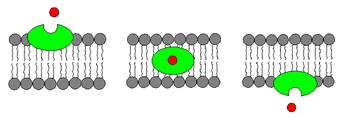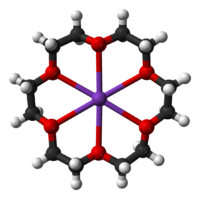
Ionophore
Encyclopedia

Ion
An ion is an atom or molecule in which the total number of electrons is not equal to the total number of protons, giving it a net positive or negative electrical charge. The name was given by physicist Michael Faraday for the substances that allow a current to pass between electrodes in a...
s across the lipid bilayer
Lipid bilayer
The lipid bilayer is a thin membrane made of two layers of lipid molecules. These membranes are flat sheets that form a continuous barrier around cells. The cell membrane of almost all living organisms and many viruses are made of a lipid bilayer, as are the membranes surrounding the cell nucleus...
of the cell membrane
Cell membrane
The cell membrane or plasma membrane is a biological membrane that separates the interior of all cells from the outside environment. The cell membrane is selectively permeable to ions and organic molecules and controls the movement of substances in and out of cells. It basically protects the cell...
. There are two broad classifications of ionophores.
- Chemical compoundChemical compoundA chemical compound is a pure chemical substance consisting of two or more different chemical elements that can be separated into simpler substances by chemical reactions. Chemical compounds have a unique and defined chemical structure; they consist of a fixed ratio of atoms that are held together...
s (mobile ion carriers) that bind to a particular ion, shielding its charge from the surrounding environment, and thus facilitating its crossing of the hydrophobicHydrophobeIn chemistry, hydrophobicity is the physical property of a molecule that is repelled from a mass of water....
interior of the lipid membrane. - Channel formers that introduce a hydrophilic pore into the membrane, allowing ions to pass through while avoiding contact with the membrane's hydrophobic interior.
Mechanism of action
Ionophores disrupt transmembrane ion concentration gradients, required for the proper functioning and survival of microorganisms, and thus have antibiotic properties. They are produced naturally by a variety microbes and act as a defense against competing microbes. Many antibiotics, particularly the macrolide antibiotics, are ionophores that exhibit high affinities for Na+ or K+. The structure of the sodium and potassium complexes of antibiotics have been repeatedly verified by X-ray crystallography.In laboratory research, ionophores are used to increase the permeability of biological membranes to certain ions. Additionally, some ionophores are used as antibiotics and/or as growth enhancing feed additives for certain feed animals such as cattle (see monensin
Monensin
Monensin is a polyether antibiotic isolated from Streptomyces cinnamonensis. It is widely used in animal feeds.The structure of monensin was first described by Agtarap et al. in 1967, and was the first polyether antibiotic to have its structure elucidated in this way...
).

Synthetic ionophores

Crown ether
Crown ethers are cyclic chemical compounds that consist of a ring containing several ether groups. The most common crown ethers are oligomers of ethylene oxide, the repeating unit being ethyleneoxy, i.e., -CH2CH2O-. Important members of this series are the tetramer , the pentamer , and the hexamer...
s, cryptand
Cryptand
Cryptands are a family of synthetic bi- and polycyclic multidentate ligands for a variety of cations. The Nobel Prize for Chemistry in 1987 was given to Donald J. Cram, Jean-Marie Lehn, and Charles J. Pedersen for their efforts in discovering and determining uses of cryptands and crown ethers,...
s, and calixarene
Calixarene
A calixarene is a macrocycle or cyclic oligomer based on a hydroxyalkylation product of a phenol and an aldehyde. The word calixarene is derived from calix or chalice because this type of molecule resembles a vase and from the word arene that refers to the aromatic building block...
s. These synthetic species are often macrocyclic
Macrocycle
A macrocycle is, as defined by IUPAC, "a cyclic macromolecule or a macromolecular cyclic portion of a molecule." In the chemical literature, organic chemists may consider any molecule containing a ring of nine or more atoms to be a macrocycle...
. Some synthetic agents are not macrocyclic, e.g., Carbonyl cyanide-p-trifluoromethoxyphenylhydrazone
Carbonyl cyanide-p-trifluoromethoxyphenylhydrazone
Carbonyl cyanide-p-trifluoromethoxyphenylhydrazone is an ionophore that is a mobile ion carrier. It referred to as an uncoupling agent because it disrupts ATP synthesis by transporting hydrogen ions through a cell membrane before they can be used to provide the energy for oxidative...
. Even simple organic compounds, such as phenols, exhibit ionophoric properties.
Appendix: list of representative biological ionophores
With the ion(s) they act upon:- A23187A23187A23187 is a mobile ion-carrier that forms stable complexes with divalent cations . A23187 is also known as Calcimycin, Calcium Ionophore, Antibiotic A23187 and Calcium Ionophore A23187...
(Ca2+) - BeauvericinBeauvericinBeauvericin is a depsipeptide with antibiotic and insecticidal effects belonging to the enniatin family. It was isolated from the fungus Beauveria bassiana, but is also produced by several other fungi, including several Fusarium species; it may therefore occur in grain contaminated with these fungi...
(Ca2+, Ba2+) - Calcimycine (A23187A23187A23187 is a mobile ion-carrier that forms stable complexes with divalent cations . A23187 is also known as Calcimycin, Calcium Ionophore, Antibiotic A23187 and Calcium Ionophore A23187...
) - EnniatinEnniatinEnniatins are a class of organic chemical compounds found in Fusarium fungi. They appear in nature as mixtures of cyclic depsipeptides. The main variants are enniatin A, A1, B and B1 together with minor amounts of enniatin C, D, E and F....
(Ammonium) - Gramicidin A (H+, Na+, K+)
- IonomycinIonomycinIonomycin is an ionophore produced by the bacterium Streptomyces conglobatus. It is used in research to raise the intracellular level of calcium and as a research tool to understand Ca2+ transport across biological membranes....
(Ca2+) - LasalocidLasalocidLasalocid is an antibacterial agent and a coccidiostat, which is produced by strains of Streptomyces lasaliensis. It is the drug in the feed additive called Bovatec....
- MonensinMonensinMonensin is a polyether antibiotic isolated from Streptomyces cinnamonensis. It is widely used in animal feeds.The structure of monensin was first described by Agtarap et al. in 1967, and was the first polyether antibiotic to have its structure elucidated in this way...
(Na+, H+) - NigericinNigericinNigericin is an antibiotic derived from Streptomyces hygroscopicus. Its isolation was described in the 1950s, and in 1968 the structure could be elucidated by X-ray crystallography. The structure and properties of nigericin are similar to the antibiotic monensin. Commercially it is obtained as a...
(K+, H+, Pb2+) - NonactinNonactinNonactin is a member of a family of naturally occurring cyclic ionophores known as the macrotetrolide antibiotics. The other members of nactins homologous family are monactin, dinactin, trinactin and tetranactin which are all neutral ionophoric substances and higher homologs of nonactin....
(Ammonium ionophore I) - NystatinNystatinNystatin is a polyene antifungal medication to which many molds and yeast infections are sensitive, including Candida. Due to its toxicity profile, there are currently no injectable formulations of this drug on the US market...
- SalinomycinSalinomycinSalinomycin is an antibacterial and coccidiostat ionophore therapeutic drug.- Use in cancer :Salinomycin has been shown by Piyush Gupta et al. of the Massachusetts Institute of Technology and the Broad Institute to kill breast cancer stem cells at least 100 times more effectively than another...
(K+) - ValinomycinValinomycinValinomycin is a dodecadepsipeptide antibiotic.Valinomycin is obtained from the cells of several Streptomyces strains, among which "S. tsusimaensis" and S. fulvissimus....
(Potassium ionophore I)

